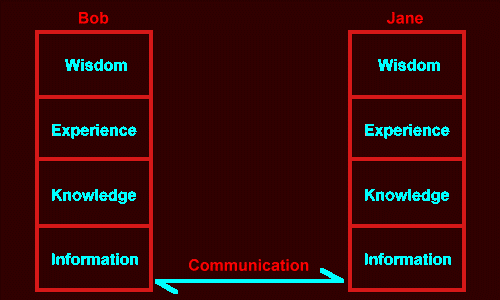(C) 2005 Hank Wallace
Remember the Information Superhighway? In the mid 1990’s, politicians predicted that they would take millions of dollars and build out a huge computer network that would link us all to unlimited shopping, pornography and gambling. Well, maybe not the pornography and gambling, but all the rest. While the politicians were outgassing about it, the telecom companies were leveraging their futures to Jupiter actually doing it. Then they lost their futures, but that’s another story.
The information on the superhighway is presumably for the benefit of people. So, how do we people process information? The answer to this question can determine the net impact of the ‘infopipe’. In terms of the popular OSI seven layer communications protocol model, each of us possesses a protocol stack like so:

Each level in the stack represents more and more organization, with less and less unnecessary fluff. For example, my parents frequently related pearls of wisdom to me as a child, but could rarely recall every informational detail of the situation in which the wisdom was gained. Likewise, I can remember the day I flipped over the handlebars of my bike and bit the asphalt, but I don’t remember what I was wearing at the time.
But what good is one protocol stack without a mate? When we diagram two stacks in the OSI style, we get the following:

The diagram illustrates the painfully small pipeline through which we communicate, made even smaller by technology. This leads to an explanation why children make some mistakes even after being warned by parents who made the same mistakes years before: We cannot communicate knowledge, experience or wisdom, only information. The transformation of that information into higher forms is up to the individual. If it were possible to communicate a brief, empathic experience of emotional or physical pain to our kids, we could in one generation wipe out drug addiction, drunk driving, and a host of other destructive evils. Clearly, the information superhighway services only the lowest level of the brain’s protocol stack, and probably then only the thinnest film on the bottom of the bucket. Let’s call it the sitcom sublayer.
So, we build the network and each of us is plugged into a one hundred megabit per second fiber, receiving a continuous stream of important and useful information. What happens then? What happens is our lower protocol layer fattens with information for which we have no use because our bloated brains have become sedentary and lethargic. Hauntingly familiar metaphor? Close to the, umm.. heart, you say? In contrast, what we need is a wisdom superhighway. Unfortunately, it seems we will have to endure a few more centuries of online shopping until we gain the wisdom needed to communicate wisdom to each other.
Author Biography
Hank Wallace is the owner of Atlantic Quality Design, Inc., a consulting firm located in Fincastle, Virginia. He has experience in many areas of embedded software and hardware development, and system design. See www.aqdi.com for more information.
